Entries tagged with “Piedmont”.
Did you find what you wanted?
Thu 6 Jan 2011
Dolcetto is a black wine grape variety widely grown in the Piedmont region of northwest Italy. The Italian word dolcetto means “little sweet one”, but it is not certain that the name originally carried any reference to the grape’s sugar levels: it is possible that it derives from the name of the hills where the vine is cultivated. In any case the wines produced are nearly always dry. They can be tannic and fruity with moderate, or decidedly low, levels of acidity and are typically meant to be consumed one to two years after release.
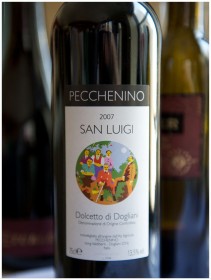 Dolcetto wines are known for black cherry and licorice flavours with some prunes and a characteristically bitter finish reminiscent of almonds. While the name implies sweetness, the wines are normally dry. The tannic nature of the grape contributes to a characteristic bitter finish.
Dolcetto wines are known for black cherry and licorice flavours with some prunes and a characteristically bitter finish reminiscent of almonds. While the name implies sweetness, the wines are normally dry. The tannic nature of the grape contributes to a characteristic bitter finish.
Recently our friend Diana, who runs the great B&B Baur in Aqui Terme, about an hour away from TorreBarolo, visited the town of Dogliani and these are her thoughts:
“A few weeks before Christmas my husband had the idea to take a ride over to the Langhe to taste some wines. He had a specific goal: he wanted to go to the Bottega del Dolcetto di Dogliani, the regional enoteca that is snuggled below the Municipio, right next to the splendid Chiesa dei Santi Quirico e Paolo in the heart of the city.
We had been to the enoteca before; it was from there that we visited the wonderful Chionetti winery for the first time in 2005. Dogliani was actually the center of our property search in 2001 and 2002 before we discovered our hill in the Monferrato. Contructed in the 12th century, Dogliani lies at the basin of the Barolo Valley. The nutrients and minerals that help the Nebbiolo grapes to flourish wash down to provide the perfect conditions for growing the Dolcetto grape. Of the eight zones officially designated to produce Dolcetto DOC, Dogliani is one of the top two. In 2005, Dolcetto Superiore di Dogliani received its DOCG status. With a minimum of 12.5% alcohol content and a hint of oak (the level depending on the winery) aging, Docetto has moved from a sharp, high tannin, low acid, quick-to-table wine with a slightly bitter residual flavor to a more rounded, softer wine that can sit in the bottle a few more years before being enjoyed with a variety of dishes typical to the region.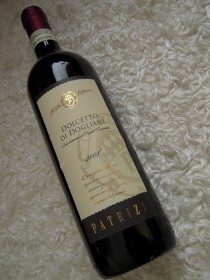
Enzo Romano, who runs the bottega, greeted us and helped Micha find the selection of wines he had been searching for. The Enoteca Regionale in Dogliani is one of the most organized and best run enoteche in the system. It has a current selection of all the producers in the appellation and a good breath of different vintages as well. Enzo helped Micha put together a healthy selection of twelve bottles of Dolcetto, both regular and superiore (wooded), for us to try. After trying, we notate the bottles we like the best and make appointments to visit those wineries.
An ideal combination of classic Piemontese food and wine might be. brodo broth made from winter capon served with boiled vegetables and agnolotti Piemontesi, alongside a 2008 Dogliani Bricco DOCG from the Cascina Minella, a vineyard brought to new life in 2002 by Livia and Gianluca Marchisio. I love this wine. It’s everything a good Dolcetto should be. It has character and bite without being agressive. Its 14% alcohol content and fullness of flavor speak of the patience and timing that the Marchisios exercised in picking the correct moment to harvest.
Dolcetto is not an easy wine to get right. We’ve been experimenting with the wine (from the tasting perspective) for years. To find dolcetto that truly maximizes the grape’s potential requires a producer with excellent soil conditions, the willingness to dedicate precious, southern exposure territory to a relatively humble wine, a sixth sense of timing regarding the harvest, the ability to stave off the many diseases this grape can contract and strong cellar knowlege. In our opinion, the two regions that have a concentration of these types of Dolcetto wineries are most likely to be found in Dogliani and Diano d’Alba.
Of course, there is tremendous enjoyment attached to searching out really spectacular wines from the bunch. Especially when that search takes you through some of the most bucolic and historic growing regions in Italy. We look forward to sharing our thoughts on the wines we’ve bought as we try them.”
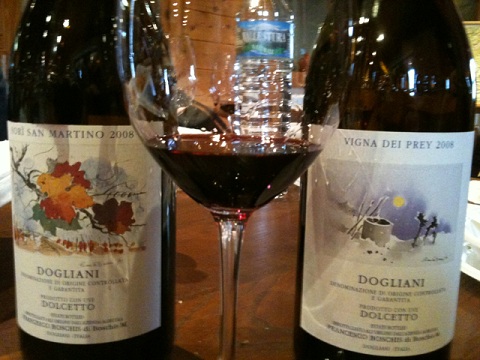
Tue 16 Nov 2010
As it was only 15:00 by the time I had completed both my lunch and giro of Asti, it was too early to head back to TorreBarolo, so I figured I may as well check out Alessandria as it was only 35km away. Alessandria is much bigger than both Alba and Asti, as evident by the fact that it has multiple exits on the Autostrada. So again, using my tried and tested method of heading towards “centro” and Piazza Liberta, I found myself in the center of the historic section of Alessandria. Again, I was surprised by the ample outside parking lots in the city center.
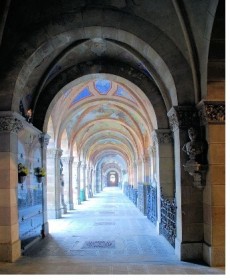 After referring to the little map of Alessandria in my Italy road atlas, I headed off towards Corso Roma, as anything with a “Roma” tends to be the city’s shopping street. At first I wasn’t too impressed but as I kept walking down this very long pedestrian street lined with various clothes and jewellery shops, I began to enjoy my stroll more and more as the well restored historic buildings lining the street really gave it a nice charm. My stroll brought me to very impressive Piazza Garibaldi. The porticos were especially impressive and added elegance to this square.
After referring to the little map of Alessandria in my Italy road atlas, I headed off towards Corso Roma, as anything with a “Roma” tends to be the city’s shopping street. At first I wasn’t too impressed but as I kept walking down this very long pedestrian street lined with various clothes and jewellery shops, I began to enjoy my stroll more and more as the well restored historic buildings lining the street really gave it a nice charm. My stroll brought me to very impressive Piazza Garibaldi. The porticos were especially impressive and added elegance to this square.
Another thing I have learned over the year is that a very nice bar (i.e., with table cloths and waiters) tends to be located on these beautiful historic piazzas. I spotted one but kept on walking as I wasn’t in need of a rest just yet. Heading away from Pizza Garibaldi up Via Maestra is when I really started enjoying my mini-adventure to this new city. Again, the street was lined with historic, well restored building though instead of clothing stores, store after store was a bakery, a pastry shop, a butcher, a fishmonger or a fruit and vegetable vendor.
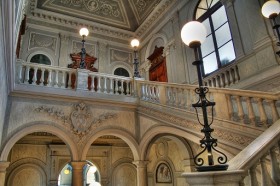 My favourite was checking out the “delis” with the cured ham hanging above the counter and the massive stacks of DOP parmigiano cheese. There was also an ample section of fresh pasta stores and one had some yummy looking take-away lasagna that I considered as an easy dinner option. The street was lively as it was now past 5pm and it was fun to watch all the ladies in their fur coats do their evening shop.
My favourite was checking out the “delis” with the cured ham hanging above the counter and the massive stacks of DOP parmigiano cheese. There was also an ample section of fresh pasta stores and one had some yummy looking take-away lasagna that I considered as an easy dinner option. The street was lively as it was now past 5pm and it was fun to watch all the ladies in their fur coats do their evening shop.
I stumbled upon a lovely arcade and tucked inside was a quaint café/patisserie. With the table cloths, wooden chairs and ladies having tea, I knew this was the perfect place to settle down for some refreshment and a read of the Herald Tribune I bought back in Asti. What a pleasure it was to find they served bicerin, which is the sumptuous hot drink that consists of layers of thick rich hot chocolate, espresso and fresh cream that originated in Turin.
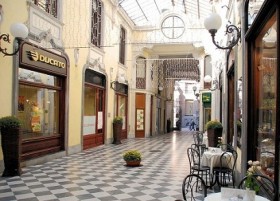 A glass of this is a meal almost, but I couldn’t resist sampling some of the yummy biscuits they had in their cases. By the time I left 40 minutes later, the tables were all filled by parents treating their kids or elderly couples having a little treat.
A glass of this is a meal almost, but I couldn’t resist sampling some of the yummy biscuits they had in their cases. By the time I left 40 minutes later, the tables were all filled by parents treating their kids or elderly couples having a little treat.
By this time it was getting colder and darker, so I thought time to head back to TorreBarolo.
So, would I recommend you have Alessandria as a day trip destination? That is tough call. It takes a bit of effort to find the old town center and doesn’t offer anything like the regal pizzas in Turin with the gorgeous turn of the century cafes. Instead, it offers no tourists, some pretty piazzas and a nice stroll down streets that you wish you had in your own neighbourhood. No question, Alessandria was a pleasant surprise but if I had limited time in the area I don’t think it offers enough to make it a day trip destination…….but I am glad I made the effort.
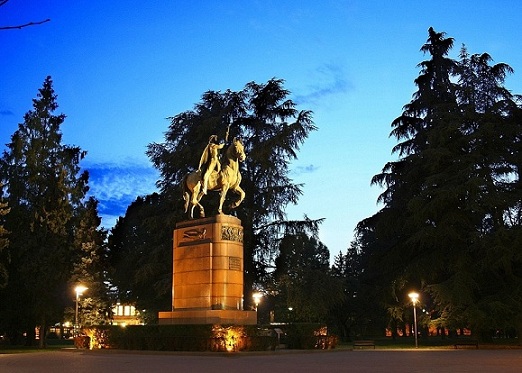
Thu 16 Sep 2010
Our wine guru Gary Chevsky enjoyed a tasting event for Italian red and white wines back in August, and shared his views with us:
“At the Chambers & Chambers trade tasting this week, I had a chance to visit and revisit many wines from all over Italy. Gourmet thin-crust pizzas from Lulu restaurant in the SOMA district of San Francisco complemented what seemed like 80-100 wines. About half the wines at the tasting were imported through Dalla Terra, founded by Brian Larky, a very funny dude. But funny is obviously not all he is – because Dalla Terra is a clever concept. They essentially eliminate one of the tiers in a 4-tier wine import distribution system, through their Winery Direct program.
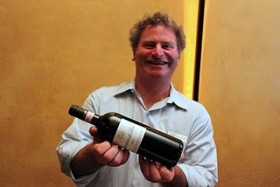 In 1989 Brian returned to the U.S. after five years as winemaker at one of my favorite sparkling wine producers in the world – Italian estate Ca’del Bosco, who makes the top Franciacorta (in Lombardy) that easily rivals top Champagne. Even Ca’del Bosco’s entry-level cuvee “Prestige” is a perennial great value sparkler. Brian founded Dalla Terra Importers in 1990. Before working in Italy, he’d earned a UC Davis Fermentation Sciences degree and held production jobs in Napa Valley wineries such as Far Niente and Domaine Chandon. Don’t be fulled by the effusive smile – the dude is clearly not just a funny dude. Whereas a usual importer markup could be 30-40%, Dalla Terra’s fee is only 15%, and that’s enough for them to run a profitable business for the past 20 years. That’s because unlike a traditional importer who has to buy and hold the inventory from the producer, Dalla Terra are a broker.
In 1989 Brian returned to the U.S. after five years as winemaker at one of my favorite sparkling wine producers in the world – Italian estate Ca’del Bosco, who makes the top Franciacorta (in Lombardy) that easily rivals top Champagne. Even Ca’del Bosco’s entry-level cuvee “Prestige” is a perennial great value sparkler. Brian founded Dalla Terra Importers in 1990. Before working in Italy, he’d earned a UC Davis Fermentation Sciences degree and held production jobs in Napa Valley wineries such as Far Niente and Domaine Chandon. Don’t be fulled by the effusive smile – the dude is clearly not just a funny dude. Whereas a usual importer markup could be 30-40%, Dalla Terra’s fee is only 15%, and that’s enough for them to run a profitable business for the past 20 years. That’s because unlike a traditional importer who has to buy and hold the inventory from the producer, Dalla Terra are a broker.
The concept is relatively common with domestic wines, but quite innovative (and difficult to implement) with imports. They never buy the wine – they connect the winery with a local US state distributor (like Chambers & Chambers), so they never have to shell out the big bucks necessary to hold the wine. Nor do they take the risk of inventory not selling. That is, the risk sits with the winery; therefore it’s reasonable to assume that the winery would retain a larger piece of the pie by quoting a relatively higher price to the distributor than they would to an importer. It’s hard to say though. I went to Wine-Searcher.com – the world’s most trusted wine comparison shopping engine – to compare local US prices to those on the Italian market of some of Dalla Terra’s wines, such as Casanova di Neri and Vietti. I found there is about a 40-50% markup in US over Italy. I then looked at some other high-end Italian producers, such as Il Poggione, Fattoria di Felsina, and Marcarini imported though Southern Wine & Spirits, Wine Warehouse, and Empson USA respectively. US prices were 40% to 125% above the Italian prices. So the price benefits of Dalla Terra were not obvious to me, but this is by no means a scientific study, and I welcome comments from folks in the wine industry. In an interview, Brian told me that Dalla Terra have about 18 producers in their all-Italian portfolio, and in 20 years they haven’t lost one. “That speaks volumes for the type of business partner we are and the type of business we bring.” said Brian.
Here are the wines I particularly enjoyed at the tasting.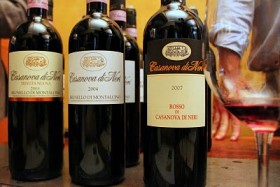
The Reds
Casanova di Neri Brunello di Montalcino 2004. This was their basic “white label” Brunello. (The 2001 Casanova di Neri Brunello made a splash with their higher-end “Tenuto Nuova” cuvee by being Wine Spectator’s #1 wine of the year in 2006.) Had this basic Brunello at the tasting and, more importantly, at a dinner next day. The wine is from the excellent 2004 vintage and is showing very well – juicy fruit, good acidity, tasty tannins. Exploding with aromas and fruit flavors, the wine is light enough to even go with fish, thanks to the excellent acidity and medium body. Delicious.
Marchesi di Gresy Barbaresco “Martinenga” 2006. Sweet, charming, red fruit, beautiful strawberry / cranberry color, gentle Nebbiolo texture, and the most accessible of any 2006 Barbarescos/Barolos I’ve tried so far. 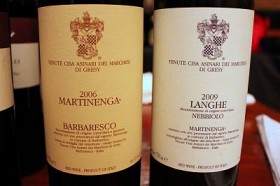
Vietti Barolo “Castiglione” 2006 – structured with slight menthol character, complex. It was the best wine match with the gourmet sausage pizza. The 2006’s are starting to open up. The 2005 “Brunate” didn’t have the menthol, but was also good. Dependable, top producer of Barolo, Vietti’s Barolo Lazzarito 2005 impressed me at the 2010 Tre Bicchieri tasting earlier this year. Their Barbera and Arneis are good too.
Vietti Barbera d’Alba “Scarrone Vigna Vecchia” 2006. Wonderfully balanced, rich, plush Barbera that tips to the much-maligned modern style, yet the delicious factor is undeniable. The most expensive Barbera I’ve ever seen ($75-100 retail). Rare, from a tiny lot in the prime Nebbiolo-caliber vineyard in Castiglione. More of a curiousity item, in my opinion, since in that price range, the wine has to be hand-sold to affluent buyers, looking for something “different”, and will be competing with high-end Barolos and Brunellos. For those who are willing to shell out big bucks for “something different”, there are options in Taurasi (from Campania), Sagrantino di Montefalco (from Umbria), and Etna Rosso (from Sicily) that come to mind before Barbera. Good wine, tough sell. 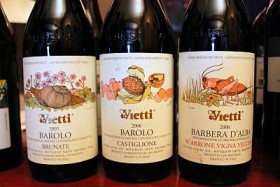
Roccolo Grassi Valpolicella Superiore “Roccolo Grassi” 2007. Single vineyard. Solid.
Roccolo Grassi Amarone “Selezione Antonio Castagnedi” 2006. All three of the Roccolo Grassi wines (including a white, mentioned below) were excellent. A producer to pay attention to. The 16-17% alc. the Amarone didn’t taste hot at all.
Selvapiana Chianti Rufina Riserva “Bucerchiale” 2006 – from a great vintage in Tuscany, excellent structure and texture, medium body. The detractor was notable heat on the palate – and lo and behold, the wine was a whopping (for a Chianti) 14-15% alc.
Cherchi Cannonau di Sardegna Rosso 2009 – good example of the native Cannonau grape of Sardinia. Very drinkable and food-friendly.
Vignalta “Gemola” 2004 – “Super-tuscan” from Veneto! (blend of Merlot and Cab Franc) – flagship of the Vignalta portfolio, well-balanced fruit/veggie, right-bank-Bordeaux like. Liked it both times. Nice effort. 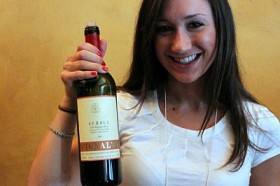
The Whites
Italian whites are a myriad of grape varietals and regions. Generally unoaked or low-oaked, crisp, food friendly, and quite interchangeable. I find Soave (from Veneto), Arneis (from Roero, Piedmont) and Ribolla Gialla (from Friuli) generally to my highest liking. But I enjoy many others depending on the particulars.
Vietti Arneis 2009 – good.
Roccolo Grassi Soave “La Broia” 2007. All three Roccol Grassi’s wines (including two reds mentioned above) were good.
Inama Soave Classico Superiore “Vigneti di Foscarino” 2007. More generous (but tasteful) oak treatment made this wine richer, more complex, more serious than a typical Soave, clearly showing the range of the Garganega grape of which Soave is made. Very good.
Marco Felluga Collio Bianco “Molamatta” 2008. Blend of Pinot Bianco, and the native Tocai Friulano and Ribolla Gialla.
A tasting like this reminds me how much I love Italian wine. And the photos of those pizzas next to the above-mentioned vino make me salivate. It’s almost lunch time here. I’m hungry. How about you?”
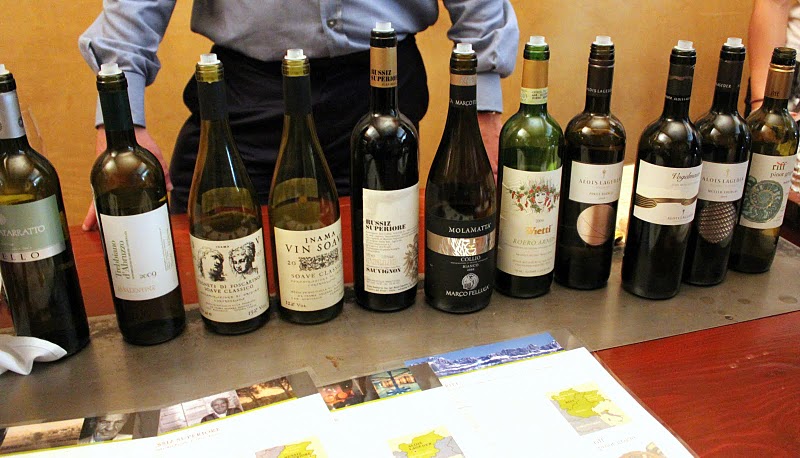
Tags: Amarone, Arneis, Barbaresco, Barbera d'Alba, Barolo, Brunello, Ca'del Bosco, Casanova di Neri, Cherchi, Dalla Terra, Franciacorta, Marchesi di Gresy, Marco Felluga, Piedmont, Roccolo Grassi, Soave, Valpolicella, Veneto, Vietti, Vignalta
Thu 3 Jun 2010
Our friend Nancy Yos, of blog At First Glass, kindly shared with us her thoughts on a 2006 Vobis Tua Barbera d’Asti from Cantine Volpi. Nancy has been blogging for three years and her posts cover a wide range of wines and regions.
2006 Vobis Tua Barbera d’Asti
Producer: Cantine Volpi s.r.l., Tortona, Italy.
Light bodied, briny piquancy — tart, underripe raspberries – a little tarry or smoky — needs food
2nd day: mellowed and silkier 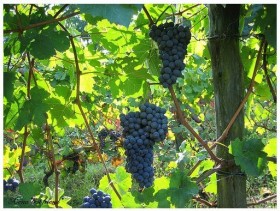
Barbera d’Asti is both a grape and a DOC (Denominazione di Origine Controllata) but note that smaller case b-barbera is the grape, while capital B-Barbera d’Asti refers to the DOC, in the lovely Piedmont region of northwest Italy, spelled in Italian Piemonte. If Italy generally conjures up images of sunshine, rolling hills, Rome, Renaissance art, and pasta, for Piedmont in particular we ought to think instead of mountains (the Alps), rushing rivers (the Po), drifting fogs, of industrial Turin, and oddly enough of rice and corn cultivation. Both are major crops here (think risotto and polenta).
For its part, our glass of Barbera d’Asti represents a sort of little brother in a hierarchy of Piedmont’s red wines, ranking below the great Barbaresco and the still greater Barolo, both named for their places of origin within Piedmont but vinified from the nebbiolo grape — which in turn is named, it seems, for the drifting fogs (nebbia). Barbera can be either Barbera d’Asti, as we have here, or Barbera d’Alba; the latter is considered just slightly more of a heavyweight than the former, which seems to be why Barbera d’Asti is an everyday what’s-for-dinner wine in this part of Italy. Barbera d’Alba is also another DOC.
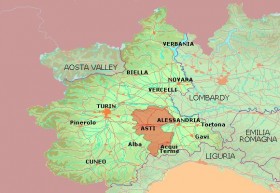 Like so many Italian red wines, except its powerhouse big brothers Barbaresco and Barolo, a Barbera has that tart, light, berry-like flavor and a texture that seems a little grainy and rough, as if a few seeds of a fresh raspberry had found their way into the bottle and added their own little interesting zip there.
Like so many Italian red wines, except its powerhouse big brothers Barbaresco and Barolo, a Barbera has that tart, light, berry-like flavor and a texture that seems a little grainy and rough, as if a few seeds of a fresh raspberry had found their way into the bottle and added their own little interesting zip there.
Wine books always emphasize that Italian wines like this, tending to be thin, fresh, and acidic, are meant to be drunk with a meal and not treated as a free-standing cocktail, which is often how we drink syrupy, barbecued-fruit California cabernets or merlots. Karen MacNeil in The Wine Bible writes rapturously of the Piedmontese food that would go with a Barbera, or even better, with its muscular big brothers, Barbaresco and Barolo: heavy meat dishes, thick risottos, eggy fresh-made pastas dressed only with butter and sage leaves or, if you are lucky and are visiting in the fall, with shavings of white truffle from Alba. The truffle’s spectacular taste, MacNeil explains in a sidebar, has been studied in science labs, and has been found to derive from some sort of chemical that is also present in the testes of men and bulls. Experienced people hunt for them at night in secret, with specially trained white dogs. Wasn’t there a commercial jingle that used to assure us Italians have more fun?
Indeed they seem to, and another of Italy’s most fun wines, Moscato d’Asti, is also a product of this same Piedmont that gives us our very serious Barolos and our zippy Barberas. Of this, I can provide just one quick tasting note: it’s flying off the shelves in grocery stores now, outperforming even queen Chardonnay and princess Pinot Grigio.
Vobis Tua, we are told, is Latin for “as you like it.” We like it. Retail: about $10-$12.
Tue 29 Dec 2009
The most impressive thing about Mondovì is the location on the top of Monte Regale with a backdrop of the Maritime Alps. Getting to the top of the hill and inside the old town center takes some effort, as being a hillside city there are many one way streets and god forbid you try and drive into the city center at 1pm when the school kids are being let out for the day. I learned the hard way that school kids have priority in Mondovì and access by car into the old town center is virtually impossible (unless of course you really do know where you are going).
That aside, once you navigate up the hill, likely you will find yourself in the pretty Piazza Maggiore, the heart of the old town center. Via Vico, which heads into Piazza Maggiore, features facades that are decorated with frescos dating back to the 15th and 16th century. Also on this street you will find an 18th century Synagogue, which is testimony to the Jewish quarter. Mondovì actually was the most populated town in Piedmont in the 16th century and is home to the first University founded in Piedmont. 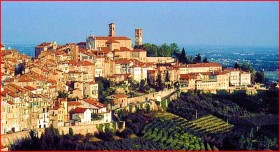
Sites:
- the Church of St. Francesco with the painting masterpiece “La Missione” by Andrea Pozzo;
- the Cathedral of St. Donato and “The Misericordia” Church, architectural masterpieces by Francesco Gallo;
- the Belvedere, the Town tower (13th century) and the spectacular facades in St. Pietro square (15th-18th century).
Another reason Mondovì makes a good day trip destination is that likely there is a cultural event or show happening. For example, in February the city host a Carnival, one of the most well known and important ones in Piedmont. In April they host a Spring fair. In August there is Handcraft fair, where pottery is one of their most famous handcrafts along with printing, wood restoration and wrought iron). On September 7th, there is a fireworks display and then at the beginning of November the truffle fair “Peccati di Gola” (sin of gluttony) kicks off which is a bounty of wines and gastronomic products of the area. 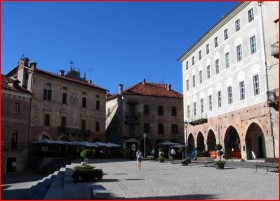
In keeping with my desire to combine day tripping with a long lunch, there is a unique restaurant in Mondovì that I would recommend, especially if you have had your fill of restaurants with exposed brick and yellow walls. Trattoria Ezzelino is a contemporary restaurant serving creative Italian dishes. Instead of the typical tomato and mozzarella salad, I remember getting served a quasi gelato/mousse of tomatoes and mozzarella. Also very unusual to find in the Langhe, there was fresh fish on the menu and I enjoyed seared tuna over a medley of fresh vegetables. (29 Via Vico. Closed Monday and Tuesday for lunch, Phone number: 017 455 8085).
From TorreBarolo, Mondovì is 34 km away and can be reached in about 35minutes. If you felt like some culture combined with some skiing, Prato Nevoso is only another 15min up into the Alps past Mondovì.
Sat 19 Dec 2009
If you are holidaying in the Langhe Valley for a week, you might want to include some sites a bit further afield. I thought it might be helpful to do a series of blogs posts on day trip destinations. I chose Saluzzo as my first destination as the view driving towards Saluzzo with Monviso (3,800 meters/12K feet) in the background is stunning in the winter. As you drive towards Saluzzo, the rolling terraced hills of the Langhe ebb away and the landscape becomes flat and is covered in fruit orchards of an extensive variety (apples, pears, kiwi, and peaches). 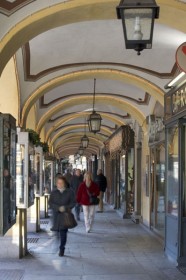
Local fruit produce is the pride of Saluzzo and dominate the “el mercà d’le fômne” (the women’s market) which is held every Saturday in the quaint setting of Via Volta. Other noteworthy products are the white Saluzzo Hen, which is high acclaimed and promoted by the Slow Food organization, as well as many excellent local cheeses from the nearby valley such as Castelmagno D.O.P and Toma d’Elva.
With a population of 17K, Saluzzo is half the size of Alba, but the many large piazzas and shopping arcades (under the canopy of arches), makes it feel bigger than Alba.
A very pleasant afternoon could be spent walking through the many shopping arcades and streets of this beautiful walled medieval city and when you need a break, the city has many cafes that are perfect for people watching. If you are hungry for some culture, the Saluzzo tourist site (which is also in English) has three excellent walking tours with maps showing the route. For example, the tour titled “Door to Door” walks you past all the noteworthy architectural and historic buildings. The other two tours are “The 19th Century” and “The Walk of the Marquis”.
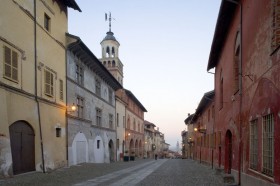
A day trip wouldn’t be complete without a wonderful lunch and I have just the place. A few years back on my very first visit to Saluzzo, I lunched at La Gargotta del Pellico and I can still remember the meal – Silvio Pellico was a patriot and writer was born in Saluzzo in 1789. The restaurant is hard to find as it is tucked away in the ancient city streets, but don’t let that put you off. When we finally found it, it was 2pm on the dot and I was worried they wouldn’t seat me and my sister for lunch, as typically 2pm is the cut off for any orders to the kitchen.
Thankfully the combination of my attempt to explain in Italian how I was lost, our mini-skirts (it was 85 degrees) and both being blonde may have helped and we were seated in an elegant dining room (with air-conditioning ).
One thing you will realize after staying a few days in the Langhe is that the menus at the restaurants are all very similar, however, just an hour away in Saluzzo you will find a refreshing new selection of Italian delicacies to enjoy. I remember for a starter my sister had a lovely lightly fried stuffed zucchini flower whereas I remember my main was fresh egg pasta with the most delicious duck (or was it boar) ragu I had ever had. For dessert we had fresh peach gelato that actually came stuffed in a frozen peach. 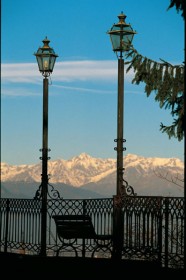
There is much to explore and writing this blog makes me want to be sure to get back on my next visit down to TorreBarolo.
Sites:
- The Cathedral, built in the years 1491-1501 and dedicated to Santa Maria Assunta and San Chiaffredo;
- The church of San Giovanni, hosting the finely sculpted sepulchre of marquis Ludwig II;
- Villa Belvedere, once the hunting residence of the Saluzzo Marquisses;
- Casa Cavassa, a symbol of the Renaissance with its 15 magnificent rooms, hosting the Civic Museum.
Saluzzo is 49km from Barolo and should take a bit under an hour by car. To reach Saluzzo, head back towards the A6 Autostrada and take the exit Bra/Marene. Head towards Savigliano and the SP662.

 Dolcetto wines are known for black cherry and licorice flavours with some prunes and a characteristically bitter finish reminiscent of almonds. While the name implies sweetness, the wines are normally dry. The tannic nature of the grape contributes to a characteristic bitter finish.
Dolcetto wines are known for black cherry and licorice flavours with some prunes and a characteristically bitter finish reminiscent of almonds. While the name implies sweetness, the wines are normally dry. The tannic nature of the grape contributes to a characteristic bitter finish.











 Like so many Italian red wines, except its powerhouse big brothers Barbaresco and Barolo, a Barbera has that tart, light, berry-like flavor and a texture that seems a little grainy and rough, as if a few seeds of a fresh raspberry had found their way into the bottle and added their own little interesting zip there.
Like so many Italian red wines, except its powerhouse big brothers Barbaresco and Barolo, a Barbera has that tart, light, berry-like flavor and a texture that seems a little grainy and rough, as if a few seeds of a fresh raspberry had found their way into the bottle and added their own little interesting zip there. 














